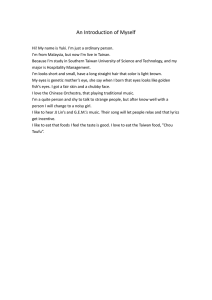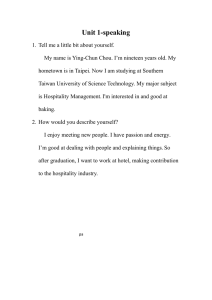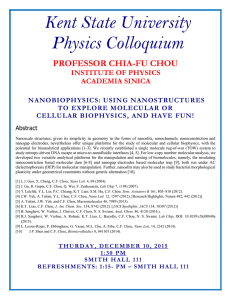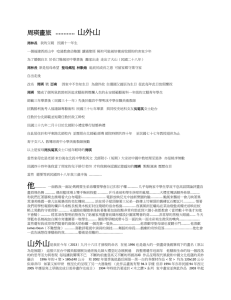A Tentative Analysis of CHOU Ying’s Woodcut Prints
advertisement
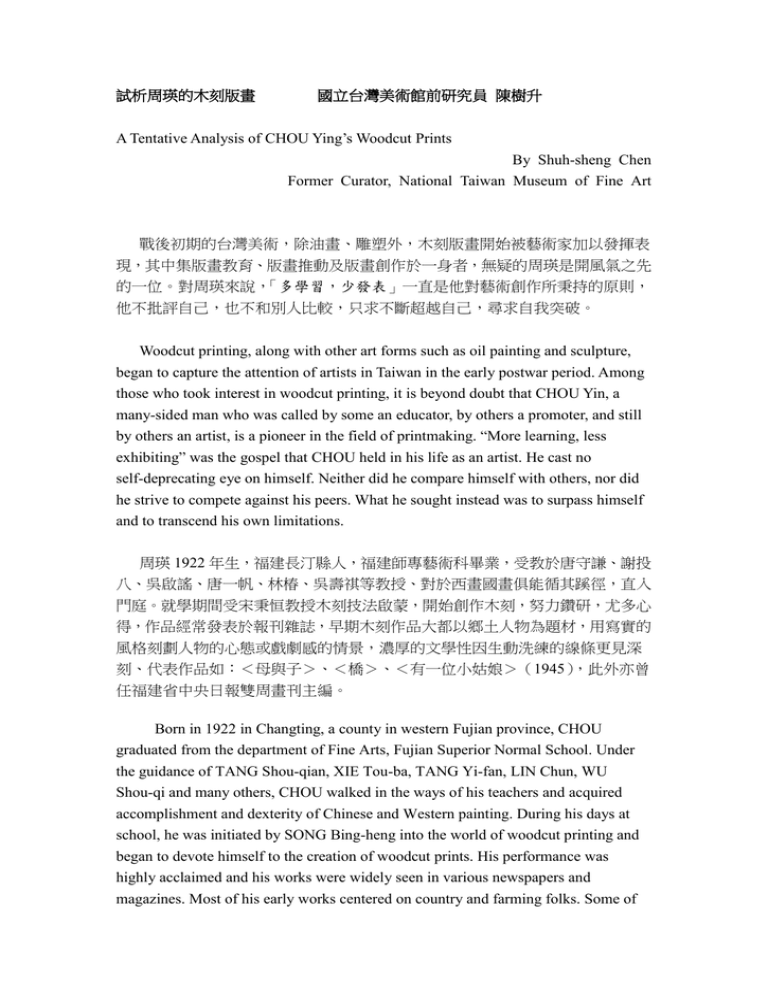
試析周瑛的木刻版畫 國立台灣美術館前研究員 陳樹升 A Tentative Analysis of CHOU Ying’s Woodcut Prints By Shuh-sheng Chen Former Curator, National Taiwan Museum of Fine Art 戰後初期的台灣美術,除油畫、雕塑外,木刻版畫開始被藝術家加以發揮表 現,其中集版畫教育、版畫推動及版畫創作於一身者,無疑的周瑛是開風氣之先 的一位。對周瑛來說,「多學習,少發表」一直是他對藝術創作所秉持的原則, 他不批評自己,也不和別人比較,只求不斷超越自己,尋求自我突破。 Woodcut printing, along with other art forms such as oil painting and sculpture, began to capture the attention of artists in Taiwan in the early postwar period. Among those who took interest in woodcut printing, it is beyond doubt that CHOU Yin, a many-sided man who was called by some an educator, by others a promoter, and still by others an artist, is a pioneer in the field of printmaking. “More learning, less exhibiting” was the gospel that CHOU held in his life as an artist. He cast no self-deprecating eye on himself. Neither did he compare himself with others, nor did he strive to compete against his peers. What he sought instead was to surpass himself and to transcend his own limitations. 周瑛 1922 年生,福建長汀縣人,福建師專藝術科畢業,受教於唐守謙、謝投 八、吳啟謠、唐一帆、林椿、吳壽祺等教授、對於西畫國畫俱能循其蹊徑,直入 門庭。就學期間受宋秉恒教授木刻技法啟蒙,開始創作木刻,努力鑽研,尤多心 得,作品經常發表於報刊雜誌,早期木刻作品大都以鄉土人物為題材,用寫實的 風格刻劃人物的心態或戲劇感的情景,濃厚的文學性因生動洗練的線條更見深 刻、代表作品如:<母與子>、<橋>、<有一位小姑娘>(1945),此外亦曾 任福建省中央日報雙周畫刊主編。 Born in 1922 in Changting, a county in western Fujian province, CHOU graduated from the department of Fine Arts, Fujian Superior Normal School. Under the guidance of TANG Shou-qian, XIE Tou-ba, TANG Yi-fan, LIN Chun, WU Shou-qi and many others, CHOU walked in the ways of his teachers and acquired accomplishment and dexterity of Chinese and Western painting. During his days at school, he was initiated by SONG Bing-heng into the world of woodcut printing and began to devote himself to the creation of woodcut prints. His performance was highly acclaimed and his works were widely seen in various newspapers and magazines. Most of his early works centered on country and farming folks. Some of them presented a realistic picture of the psychological aspects of human beings, while others captured a dramatic moment of human life. The refined lines created by his artistic hand not only breathed life into his works but also brought out the literary nature of them. Prints representative of his works included Mother and Son, Bridge, A Lass 1945, to name a few. He was also once the editor in chief of the pictorial bi-weekly magazine by Fujin Central Daily News. . 1948 年周瑛來台,即任教於台北師範學校(今國立台北教育大學)直至退休, 除授西畫外,兼教木刻,蕭勤、何恭上、何政廣兄弟、李錫奇、倪朝龍等皆為其 高足。來台初期作品有刻劃出對故鄉之情的懷念,充滿了故鄉情思,如<講故事 (說故事)>、<小姑娘>(1948)等。課餘之暇,周瑛走遍大街小巷,看過無 數城市、優美鄉間,他感性地一刀一痕刻劃出台灣民間特有的純樸祥和景色,< 日出>(1948) ,描繪農民日出辛苦工作的一面,<春滿人間>(1949) ,刻繪春 日和樂、豐饒大地的鄉間一景,其它作品如<牧>、<土石流>(1949)等,都 記錄當時的農村的情況。以上這些作品都是純黑白木刻,犀利流暢線條構成繪織 的台灣鄉土風情寫實木刻力作。 From his arrival in Taiwan onwards, CHOU had taught western painting and woodcut printing until his retirement day at National Taipei Teachers College (now the national Taipei University of Education). Acclaimed artists studying under his instruction included HSIAO Chin, HE Gong-shang and his brother HE Zheng-guang, LEE Shi-chi, NI Chao-long and many others. Works created in his early days in Taiwan emanated a deep sense of nostalgia. Story-Telling and A Lass were typical examples in which he expressed his great yearning for home after a prolonged absence. During his leisure time after class, CHOU would meander along streets, enjoying the diverse scenes he saw from cities to cities or in the beautiful rural areas. Carving every line with tender feelings, CHOU portrayed the simple and peaceful life that the folk lived. Sunrise 1948, for example, depicted the fatiguing and laborious work that famers started at dawn. The Spring of the Year 1949, on the other hand, gave a glimpse of the merry and flourishing country life in spring. Other works like Pasturing and Mudslide 1949 faithfully recorded the daily country life in those days. All the said works were brilliant black-and-white woodcut prints in which lines carved in a free style wove together to give a vivid profile of the rural scenes in Taiwan. 在 1950 年代強調反共文藝的時潮中,流於政令宣傳出路的木刻版畫是一種最 方便的創作方式。當時除軍中的方向外,周瑛也與抗戰勝利後來台的木刻家如陳 其茂、陳洪甄、朱嘯秋等人,在各報刊媒體,發表富有濃厚政治宣傳意味,充滿 戰鬥性的作品,如<一封家書>,是根據張自英所撰寫的詩-「燈下」,有感而 發之作。畫中人物噙著眼淚,一遍遍細讀家書,而家書中所寫的是四萬萬五千萬 同胞痛苦的訴說,復仇的怒火似乎從心底燃燒起來。周瑛透過精雕細刻,構成一 幅感人的畫面。其他作品如<老兵>、<痛飲黃龍>等。 In the 1950s, a prevalent anti-communist sentiment gave rise to an art style used as political propaganda. In the midst of the anti-Communist climate, woodcut prints served well as vehicles for propaganda as well as an expedient way of artistic creation. Woodcut printmakers in this period more often than not published in newspapers and magazines prints full of bellicose spirit. Apart from FANG Hsiang, the soldier artist, among these woodcut printmakers are CHOU and other artists who arrived in Taiwan after the War of Resistance against Japan, such as CHEN Chi-mao, CHEN Horng-jin, and CHU Hsiao-chiu. A Letter from the Family was characteristic of CHOU’s works in this period. Inspired by ZHANG Zi-ying’s poem, “Under the Lamp,” CHOU pictured the sentiments of sadness, pains, anger and hatred overflowing from the bosom of a man who was reading a letter from his family that accounted the agony of his fellow people. Through CHOU’s artistic dexterity, the touching moment was made to last forever. His works created during this period included An Old Soldier and A Feast of Overwhelming Victory. 1978 年起周瑛在藝術創作上有很大的突破,獨創一套特殊的模版拓印技法, 由「刻」轉變為「拓」的方式,創作一系列「石之頌」之類的作品,他用獨特的 石之語彙發揚光大,創造了現代造形版畫的具體生命意義,這些系列作品分別於 1983 和 1987 年兩度榮獲中華民國國際版畫雙年展「文建會主委獎」殊榮。 Starting from 1978, CHOU had successfully surpassed himself and achieved significant breakthrough in art creation. He came up with unique techniques of frottage and started to use rubbing instead of carving to create prints. The Song of Stone series was the fruit of his efforts, in which he made the world hear the sound of stone and gave a concrete shape to modern picture print art. His brilliant performances won himself the CCA Minister’s Award for Excellence in the 1st and 3rd ROC Biennial, held respectively in 1983 and 1987. (上一次寫陳先生寫的是 1985,還是我上次翻 錯了。@_@) 1980 年代後期周瑛在「石之頌」系列的作品外,也出現了抽象木刻,如<作 品 88-6>、<作品 88-7>。而鑒於台灣解嚴前後,一個批評時政的風氣,成 為激發社會力的最主要話題。此時周瑛也有政治議題上的抒發之作,1987 年的 <稻草人>,從批判立法院議事殿堂的肢體語言開始,對這些以暴力較勁,而缺 乏理性論政的議堂現象,表達社會大眾的不滿。此作以突顯的特寫手法、簡潔的 筆調,敘說著最直接而具體的意見。另外,<祈>為 1994 年抽象木刻作品。 Aside from the Song of Stone series, CHOU in the 1980s also started to produce abstract woodcut prints like Work 88-6 and Work 88-7. Additionally, the critical spirit that characterized the time around the end of martial law gave a fresh impetus to the growing social force. CHOU, without exception, was under the influence of such a political climate and gave expression to his concern for political issues in some of his works. A Scarecrow was a work intended to level criticism at the physical violence taking place in the parliament. CHOU reflected in this work the widespread condemnation of the violent clashes between lawmakers. Also reflected in the work was the prevalent disapproval of a lack of rational reasoning during the lawmaking process. In a concise manner, A Scarecrow faithfully and forcefully reflected the popular view of such a political phenomenon. His well-known abstract woodcut prints included Prayer, a work produced in 1994. 周瑛在台北師範執教四十年,春風化雨,奉獻美術教育,培育不少藝術英才, 藝術創作上,在傳統風格外另創新形式新技法,此外又參與版畫藝術活動,創立 組織「中華民國版畫學會」 ,積極投入會務,對版畫推廣貢獻良多,並啟迪後進, 其在台灣美術史上自有一定地位。 CHOU Ying had taught at National Taipei Teachers College for forty years, where he dedicated himself to teaching art and educating young artists. As an artist, he himself was adventurous to take the path trodden by none before rather than stood fast in the old ways of his forerunners. In addition, he devoted his time and efforts to various art activities to help promote printmaking. He was one of the founder members of Printmaking Society of the Republic of China, in which he took an active part, taking care of certain administrative manners. CHOU’s contribution to the promotion of printmaking is undeniable, so is his devotion to talent cultivation. CHOU Ying is certainly one of the most important figures in the art history of Taiwan that people will never forget.
